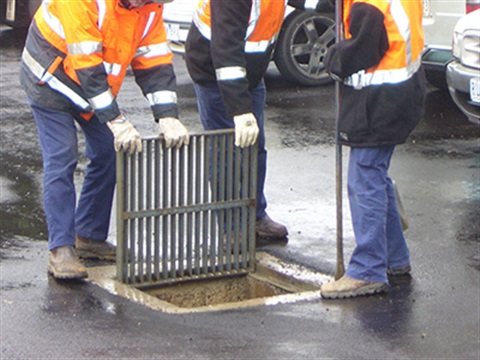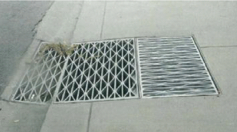Blocked or overflowing drains

Council is responsible for the maintenance of more than:
When it rains, water, litter and other debris run off roads, car parks, roofs and other surfaces into the nearest drains or waterway.
Each year, our officers inspect approximately 9,000 street drains and pits across the shire and our fortnightly footpath and street sweeping programs help to reduce the amount of waste, sediment and other debris that can block drains and cause localised flooding.
There are a range of different drains and pits in the Macedon Ranges, some maintained by Council and some by other agencies. Below you'll find information to help you identify the type of drain and the appropriate authority who can help you with your maintenance request.
Pits and drains

Grated pit—storm water pit covered with a metal grate to stop rubbish entering the drain.
Side entry pit—located on a kerb and channel to catch stormwater from a road surface.
Kerb and channel—located on the roadside for road drainage and to provide a roadside barrier.
Table drain—V-shaped drain located on the edge of the road.
Silt trap—captures sediment from water runoff.
Telstra pit—rectangular pit located on the footpath with a concrete cover. Call Telstra on 13 22 03 or report damage online.
Driveway culverts
Driveway culverts are usually installed to provide access to private property.
The RMA (Road Management Act) provides that Council is not liable for private vehicle crossings specifically required for property access. The landowner is responsible for these assets and for ensuring the vehicle crossing including the immediate surrounds that the vehicle crossing impacts on is maintained in a fit for purpose safe condition.
Property owners are responsible for ensuring their driveway culvert is of sufficient size, located in the correct position and clear of debris. It is recommended that driveway culverts are checked regularly by residents and any debris removed, particularly following storm events.
To allow sufficient flow of water through the drainage system, it is recommended a minimum size and type of pipe is used beneath driveway crossings. Pipes that are undersized or of low structural integrity may compromise access to and from your property and the optimal functionality of the drainage system. If you wish to install or upgrade your driveway culvert, you may require an asset protection permit prior to the commencement of any works.
In some instances we will assist with the clearing of culverts but only when the blockage appears to have resulted from issues with Council controlled assets (e.g. crushed rock washed into drain from road during a storm).